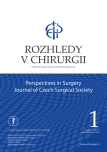High resolution anorectal manometry in patients with anorectal dysfunctions and the therapeutic consequences
Authors:
K. Košťálová; M. Zavoral; Š. Suchánek
Authors‘ workplace:
Interní klinika, 1. lékařská fakulta, Univerzita Karlova a Ústřední vojenská nemocnice – Vojenská fakultní nemocnice, Praha
Published in:
Rozhl. Chir., 2022, roč. 101, č. 1, s. 28-36.
Category:
Original articles
doi:
https://doi.org/10.33699/PIS.2022.101.1.28–36
Overview
Introduction: High resolution anorectal manometry (HRAM) is a diagnostic method indicated in patients with anorectal dysfunction. The aim of the study was to evaluate the prevalence of anorectal dysfunctions and to assess therapeutic consequences.
Methods: Retrospective data of consecutive patients referred to HRAM in the period from March 2019 to February 2021 were evaluated. Basic manometric parameters were assessed: resting pressure (RP), maximal squeeze pressure (SP), rectal sensitivity (RS), and dyssynergic defecation (DD).
Results: 113 patients with combined fecal incontinence and obstructive defecation syndrome (FI + ODS: 44.2%), fecal incontinence (FI: 26.5%), obstructive defecation syndrome (ODS: 16.8 %), stoma before restoration of intestinal continuity (6.2%), functional pelvic pain (FP: 3.5 %) and controversial cases (2.7%) were analyzed. The average age was 54 years; female patients predominated (72 %). Patients with FI and FI+ODS had lower mean RP (57 mmHg and 53 mmHg) and/or lower SP (160 mmHg and 140 mmHg) compared to baseline. Patients with ODS had normal values of mean RP (75 mmHg) and SP (225 mmHg). DD was noted in most patients (FI: 76.6%, FI + ODS: 88%, ODS: 89.5%, FP: 100%). Conservative therapy with pelvic floor physiotherapy was provided in most cases (FI+ODS: 40%, ODS: 36.8%, FI: 13.3%, FP: 75%).
Conclusion: In patients with defecation disorders there is a high prevalence of pathological manometric findings that combine with each other. Based on manometric findings, conservative treatment with individual pelvic floor physiotherapy can be initiated.
Keywords:
anorectal manometry – anorectal dysfunction – pelvic floor physiotherapy
Sources
1. Patcharatrakul T, Rao SSC. Update on the pathophysiology and management of anorectal disorders. Gut Liver 2018 Jul 15;12(4):375–384. doi: 10.5009/gnl17172.
2. Koželuhová J, Balihar MK, Janská E, et al. High-resolution anorektální manometrie - up date v diagnostice anorektálních poruch. Gastroenterologie a hepatologie. 2014;68(4)330–339.
3. Carrington E, Scott S, Bharucha A, et al. Advances in the evaluation of anorectal function. Nat Rev Gastroenterol Hepatol. 2018;15 : 309–323. doi:10.1038/nrgastro. 2018.27.
4. Seo M, Joo S, Jung KW, et al. New metrics in high-resolution and high-definition anorectal manometry. Curr Gastroenterol Rep. 2018;20(12):57. Published 2018 Nov 5. doi:10.1007/s11894-018-0662-5.
5. Carrington EV, Heinrich H, Knowles CH, et al. The international anorectal physiology working group (IAPWG) recommendations: Standardized testing protocol and the London Classification for disorders of anorectal function. Neurogastroenterol and Motil. 2019. doi:10.1111/nmo.13679.
6. Rao SS, Bharucha AE, Chiarioni G, et al. Anorectal disorders. Gastroenterology 2016;150(6):1430–1442. https://doi. org/10.1053/j.gastro.2016.02.009.
7. Khera AJ, Chase JW, Salzberg M, et al. Gut-directed pelvic floor behavioral treatment for fecal incontinence and constipation in patients with inflammatory bowel disease. Inflamm Bowel Dis. 2019;25(3):620–626. doi:10.1093/ibd/izy344
8. Narayanan SP, Bharucha AE. A practical guide to biofeedback therapy for pelvic floor disorders. Curr Gastroenterol Rep. 2019;21(5):21. Published 2019 Apr 23. doi:10.1007/s11894-019-0688-3.
9. Panman C, Wiegersma M, Kollen BJ, et al. Two-year effects and cost-effectiveness of pelvic floor muscle training in mild pelvic organ prolapse: a randomised controlled trial in primary care. BJOG 2017;124(3):511–520. doi:10.1111/1471 - 0528.13992.
10. Ihnát P, Kozáková R, Vávra P, et al. Fekální inkontinence – závažný medicínský a společenský problém. Časopis lékařů českých 2016;155 : 135–140. ISSN 0008 - 7335.
11. Ihnát P, Vávra P, Guňková P, et al. 3D high resolution anorectal manometry in functional anorectal evaluation. Rozhl Chir. 2014; 93(11):524–529.
12. Benezech A, Cappiello M, Baumstarck K, et al. Rectal intussusception: can high resolution three-dimensional ano-rectal manometry compete with conventional defecography? Neurogastroenterol and Motility 2017;29(4). doi:10.1111/nmo.12978.
13. Heitmann, PT, Rabbitt, P, Schloithe, AC, et al. The relationships between the results of contemporary tests of anorectal structure and sensorimotor function and the severity of fecal incontinence. Neurogastroenterology and Motility 2020; 32:e13946. doi: 10.1111/nmo.13946.
14. Parker CH, Henry S, Liu LWC. Efficacy of biofeedback therapy in clinical practice for the management of chronic constipation and fecal incontinence. J Can Assoc Gastroenterol. 2019;2(3):126–131. doi:10.1093/jcag/gwy036.
15. Rattan S, Singh J. Basal internal anal sphincter tone, inhibitory neurotransmission, and other factors contributing to the maintenance of high pressures in the anal canal. Neurogastroenterol and Motility 2011;23(1):3–7. doi:10.1111/j.1365 - 2982.2010.01629.x.
16. Bharucha AE. Update of tests of colon and rectal structure and function. J Clin Gastroenterol. 2006;40 : 96–103. doi: 10.1097/01.mcg.0000196190.42296.a9.
17. Ahn JY, Myung SJ, Jung KW, et al. Effect of biofeedback therapy in constipation according to rectal sensation. Gut Liver 2013;7(2):157–162. doi:10.5009/ gnl.2013.7.2.157.
18. Ussing A, Dahn I, Due U, et al. Efficacy of supervised pelvic floor muscle training and biofeedback vs attention-control treatment in adults with fecal incontinence. Clin Gastroenterol Hepatol. 2019;17(11):2253–2261.e4. doi:10.1016/j. cgh.2018.12.015.
19. Pourmomeny AA, Emami MH, Amooshahi M, et al. Comparing the efficacy of biofeedback and balloon-assisted training in the treatment of dyssynergic defecation. Can J Gastroenterol. 2011;25(2):89 – 92. doi:10.1155/2011/268062.
Labels
Surgery Orthopaedics Trauma surgeryArticle was published in
Perspectives in Surgery

2022 Issue 1
- Metamizole vs. Tramadol in Postoperative Analgesia
- Safety and Tolerance of Metamizole in Postoperative Analgesia in Children
- Metamizole in perioperative treatment in children under 14 years – results of a questionnaire survey from practice
- Obstacle Called Vasospasm: Which Solution Is Most Effective in Microsurgery and How to Pharmacologically Assist It?
Most read in this issue
- High resolution anorectal manometry in patients with anorectal dysfunctions and the therapeutic consequences
- Endoscopic management of gastrointestinal motility disorders
- Incarcerated left paraduodenal hernia − case report and literature review
- Successful repeated gastric peroral endoscopic myotomy (re-G-POEM) in the treatment of postsurgical gastroparesis
